By following this guide, you’ll get the knowledge to help you make better decisions when you’re working with data. Whether you are a newbie or a seasoned pro, this guide has your back.
When you reach the end of this guide, you will be able to use different data types confidently and feel like part of a fantastic club that gets it.
Let’s get started!
Contents
1. Primitive Data Types
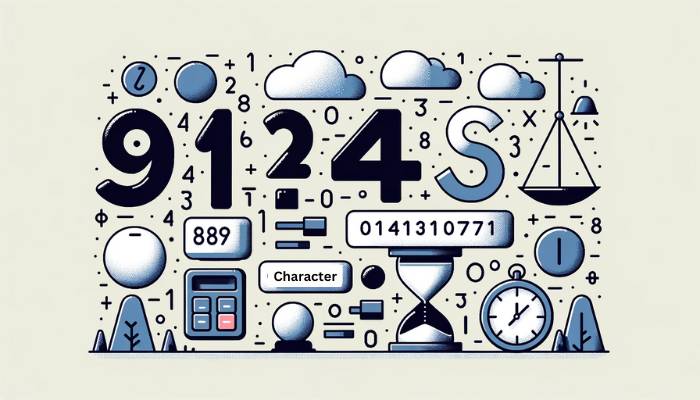
Data types are an essential component of programming languages. They provide a way to store and structure data for computers to process.
Primitive data types are the most basic data type that contain simple values such as numbers or characters.
- Strings – sequences of characters
- Numbers – integers and floats
- Booleans – true/false values
- Nulls – the absence of any value
Primitive data types can help us define our variables, manipulate them with operations like addition and subtraction, compare them using comparison operators, and even create more complex structures like loops or functions.
By understanding primitive data types better, we can get closer to unlocking the power of computer programming. With this knowledge at hand, let’s move on to exploring non-primitive data types.
Question: Is a String a Primitive Data Type?
Yes, a string is considered a primitive data type or a basic type of data in most programming languages. It is used to store text data and is made up of a sequence of characters.
In computing, a basic data type that is not constructed from other data types is referred to as a primitive data type.
2. Non-Primitive Data Types
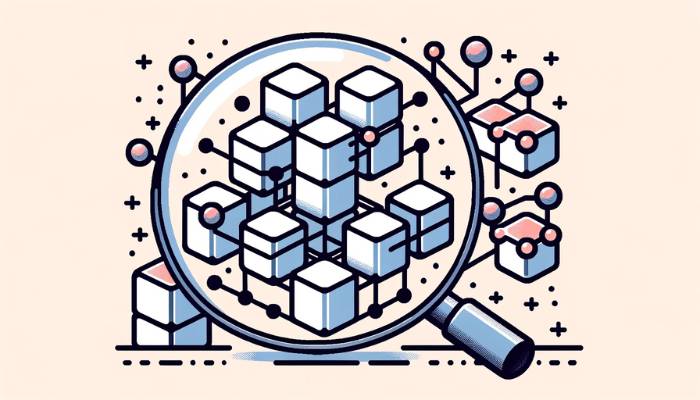
Unlike primitive data types, non-primitive ones are more complex and can store multiple values. They include reference or pointer types, structured types, and enumerated types.
Let’s take a look at each type in the following table:
| Data Types | Description |
| 1. Reference/Pointer Types | These point to other objects stored elsewhere in memory |
| 2. Structured Types | These contain several different pieces of information combined into one object |
| 3. Enumerated Types | These hold predefined constants for easy comparison and manipulation |
1. Arrays and strings commonly use Reference/pointer types, efficiently manipulating large amounts of related data without repetitive copying.
2. Structured types allow us to group related variables under one name, making them much easier to manage when dealing with larger datasets.
3. Lastly, enumerated types let you assign simple names or numbers to specific values, which makes them ideal for comparing results from different operations.
Non-primitive data types offer many advantages over their primitive counterparts, giving developers greater flexibility when working with data sets. With these powerful tools, we can create complex programs that handle large volumes of information quickly and accurately.
Now let’s explore numeric data types such as integers, floats, and booleans – essential components of any programmer’s toolkit!
3. Numeric Data Types
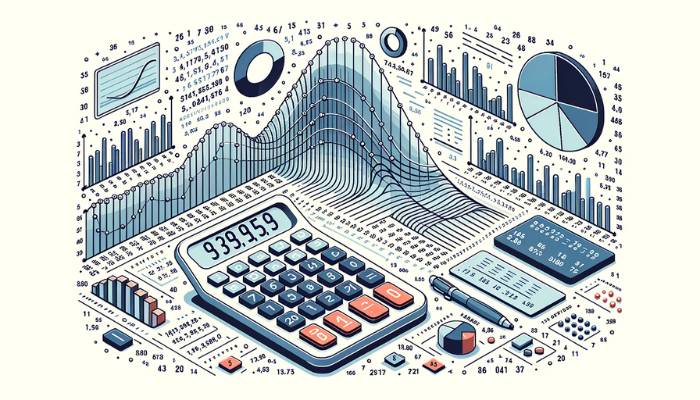
Numeric data types are among the most common data types used in programming. Numbers are represented by two categories: integer values and floating-point values.
Integer values are whole numbers that don’t contain any digits after a decimal point, whereas floating-point values include digits after a decimal point. Depending on their size, they may also have an exponent notation to indicate a large or small number.
I. Sizes of Values
Different programming languages offer varying numeric formats for integer values, which come in sizes like 8-bit, 16-bit, 32-bit, and 64-bit, indicating the allocated memory.
For example:
JavaScript allows for integers up to 53 bits long, while C# is limited to only 32 bits due to its reliance on signed integers. Floating-point values range from single precision (32 bits) to double precision (64 bits).
No matter what numeric value you use, it’s crucial to understand how many bytes each requires so your program has enough memory allocated for it. Knowing this information helps ensure that your code runs more efficiently and with fewer errors during execution. With this knowledge, you’ll feel confident when dealing with numerical types in your programs and projects.
Character data types are another fundamental part of programming languages that allow us to store strings of text representing words or phrases.
3. Character Data Types

Moving on from numeric data types, let’s look at character data types. Character data types store text values and represent the letter ‘C’ in some programming languages. They can store names, addresses, words, or phrases – anything that requires more than one character!
Character data types may vary depending on your language but usually come as fixed or variable strings.
Fixed-length strings allow for a set number of characters, while variable-length strings adjust automatically based on how much information they store. This makes managing large amounts of text much easier without worrying about overflowing memory limits!
Understanding how character data type works are essential to use text effectively in your code. It ensures that your textual inputs remain consistent throughout your program, so ensure you understand this concept before diving into coding with readers!
Now let’s explore booleans – these are unique binary variables with only two possible outcomes: true or false.
4. Boolean Data Type
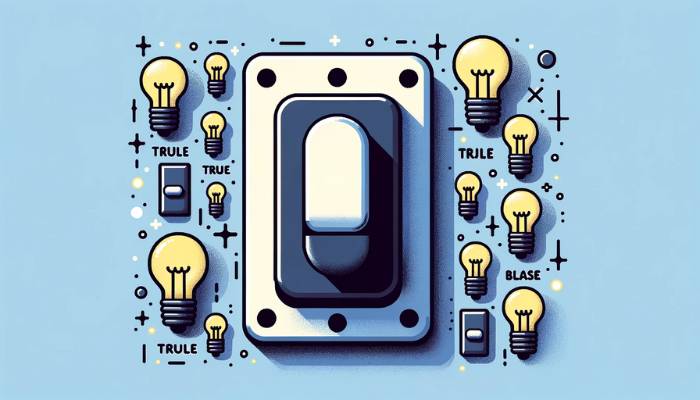
Boolean Data Type is a simple data type that can take two possible values: true or false. It’s commonly used in programming and database systems to represent decisions, conditions, and more.
Note: This data type makes it easier for developers to create logic-based applications as we only have to deal with two outcomes instead of multiple possibilities.
When dealing with Boolean Data Type, you must follow some essential rules. For example, both the true and false values should be lowercase – uppercase letters will not work correctly. Enclose each value with single quotation marks to prevent confusion with other variables.
Finally, when writing an expression involving Booleans, make sure all operators (such as ‘and’ or ‘or’) are also lowercase.
Now that you know the basics of working with Boolean Data Types, you’re ready to start creating complex logical statements within your codebase!
5. Comparing Data Types: Nominal vs. Ordinal and Discrete vs. Continuous
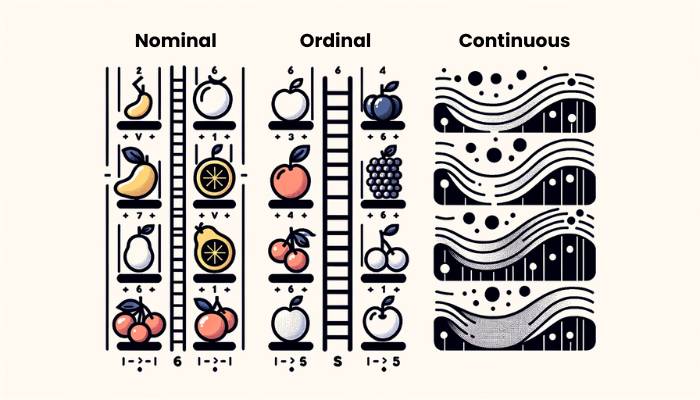
Understanding the nuances between different data types is crucial. Two sets of comparisons that often arise are between Nominal and Ordinal data types, and Discrete and Continuous data types. Let’s delve into these comparisons to gain a clearer understanding.
I. Nominal vs. Ordinal
- Nominal Data:
- Definition: Nominal data represents categories or labels that have no inherent order or ranking.
- Examples: Colors (Red, Blue, Green), Genders (Male, Female, Non-Binary), Types of fruits (Apple, Banana, Cherry).
- Characteristics:
- Purely qualitative.
- Cannot be arranged in a meaningful order.
- Arithmetic operations are not applicable.
- Ordinal Data:
- Definition: Ordinal data represents categories that have a specific order or ranking to them, but the intervals between the ranks might not be uniform.
- Examples: Education level (High School, Bachelor’s, Master’s, PhD), Customer satisfaction ratings (Poor, Average, Good, Excellent).
- Characteristics:
- Qualitative in nature but has a meaningful order.
- Differences between consecutive ranks might not be consistent.
- Can be arranged in ascending or descending order.
Key Takeaway: While both nominal and ordinal data types represent categories, ordinal data has an inherent order, whereas nominal data does not.
II. Discrete vs. Continuous
- Discrete Data:
- Definition: Discrete data can only take specific, distinct values, often counted in whole numbers.
- Examples: Number of students in a class, shoes sizes, number of cars in a parking lot.
- Characteristics:
- Has distinct and separate values.
- Often counted, not measured.
- Finite number of possible values within a given range.
- Continuous Data:
- Definition: Continuous data can take any value within a given range and can be measured with great precision.
- Examples: Height of individuals, weight of fruits, time taken to run a race.
- Characteristics:
- Has an infinite number of possible values within a given range.
- Measured, not counted.
- Can be broken down into finer and finer levels of precision.
Key Takeaway: Discrete data is countable and distinct, while continuous data is measurable and can take an infinite number of values within a given range.
6. The Most Efficient way to Store Large Volumes of Data

When dealing with large volumes of data, efficiency is critical. How you store and organize your data can make or break the success of any project. There are many ways to go about it, so how do you know which is right for you?
The most efficient way to store large volumes of data is ultimately up to personal preference and the type of data you’re working with.
However, some general guidelines may help in making this decision:
- Consider cloud storage options such as Microsoft Azure or Amazon S3; these provide a secure environment for your information while scaling when needed.
- Think about using an open-source database like MongoDB or PostgreSQL; both offer powerful features at low cost.
- Investigate traditional relational databases such as Oracle and SQL Server, which have been around for decades but still provide reliable performance.
No matter what option you choose, there are a few things to remember when storing large amounts of data — security, scalability, and ease of use.
Understanding the tradeoffs between each solution before committing to one over another; having access to fast and accurate information is invaluable! That said, taking the time to research potential solutions will pay off in the long run by ensuring your organization has access to reliable and secure sources of information.
You shouldn’t take Data storage lightly; investing in quality tools now means saving money (and headaches) down the line. With careful consideration and research upfront, organizations can find a system that meets their needs without breaking the bank.
7. Performance Implications of using different Data Types
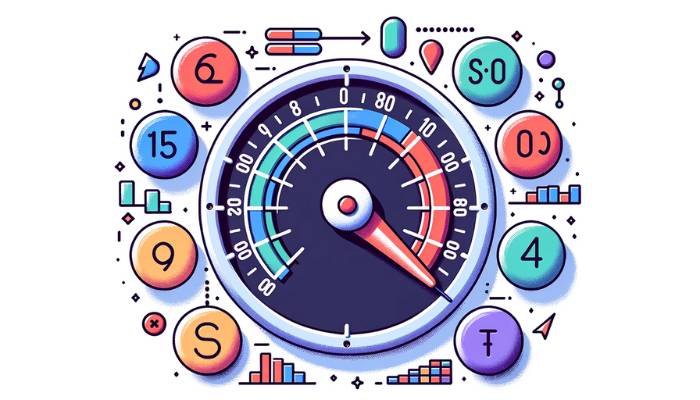
When storing large volumes of data, understanding the performance implications of different data types is critical.
Different data types reduce memory usage and increase storage capacity when stored efficiently, but they also have advantages and disadvantages. From scalability to easy retrieval, considering the pros and cons is essential for any business looking to optimize its workflow.
Your data type can significantly impact the speed at which your system processes information.
For Example:
Using an integer instead of a string can drastically improve search time by reducing comparison operations. On the other hand, some systems may require more complex data structures that consume resources like memory or processing power to execute queries or perform calculations accurately.
Choosing the right mix of data types depends heavily on how you plan to access and manipulate your data and what kind of workloads you expect from your users.
It’s essential to consider both short-term gains in efficiency and long-term stability – optimizing one aspect may decrease performance if not properly managed. With careful analysis and thoughtful management, businesses can make intelligent decisions regarding their data structure and use cases for maximum benefit.
8. Ensure Data Integrity when using different Data Types

Maintaining data integrity when using different data types can be tricky. After all, if the data isn’t secure and accurate, it won’t reflect reality or provide valuable insights.
So, how can you ensure your data remains intact? Let’s take a look.
- First, it’s essential to understand what type of information you’re dealing with: Is it structured or unstructured?
- How large is the dataset?
- What technology are you working with?
Knowing these details will help guide which security protocols must be in place for each case. Additionally, understanding the data lifecycle – from creation to storage and analysis – will also give an idea of which steps require extra attention for better protection.
Finally, consistent monitoring throughout every stage of the data journey is essential for catching any discrepancies that could arise. Regular checks should include automated and manual reviews to ensure everything is up-to-date and valid.
Having backup plans in place will help to quickly and easily recover the source without compromising accuracy or security if something goes wrong. Taking these measures will allow you to trust the reliability of your datasets, no matter what type they may be.
9. Structure the Data for Easy Query

Structuring data can make all the difference in getting meaningful results from your queries. It’s like putting together a jigsaw puzzle – if you don’t have the right pieces, it won’t work!
But how do you know what structure is best for your data?
When dealing with varying data types, there are three main points to consider: organizing, storing, and indexing. By taking each step individually and focusing on the details, creating an efficient system that meets your needs will be easier.
Here’s how you can get started:
I. Organizing
Your data requires careful planning, as this will set up the foundation of your query structure. Identify information types to track, and break them into specific fields for easy access via keywords/filters.
II. Storing
Storing the data is also crucial since large datasets require extra attention to ensure everything stays organized.
Consider using a database management system such as MySQL or PostgreSQL to store multiple tables with related information so you can quickly access any part of it whenever needed.
Additionally, use version control systems like Git or Subversion to keep track of changes over time.
III. Indexing
Indexing is critical for optimizing searches within larger datasets and ensuring that queries return accurate results on time. Indexes provide faster access times by creating an alternate representation of identical records to be searched more efficiently without scanning every item in the table first.
Having clear guidelines helps streamline development and maintenance processes, allowing teams to stay focused on their tasks instead of wasting precious hours trying to figure out where something went wrong or why certain things aren’t working correctly – saving money and providing peace of mind!
With these basics covered, developers can now move on to building intuitive tools that help users find what they’re looking for with minimal effort required on their end.
10. Best Suited Data Types for Machine Learning Applications

Regarding machine learning applications, your data type can make or break a project. Choose data types carefully to ensure optimal performance, as they are fundamental.
We’ll look at some of the best-suited data types for ML applications:
- Numerical Data Types
- Integers
- Floats
- Categorical Data Types
- Strings
- Booleans
As someone looking to harness the power of Machine Learning with your data, numerical data types such as integers and floats provide invaluable insights that help inform your decisions.
Integers are whole numbers, while floating point numbers have decimal points, allowing us to efficiently represent fractions and very large or small values.
These two forms of numerical data are essential when working on predictive models like regressions, where numbers must be precise and accurate.
I. For SuperVised Learning Models
Categorical data types can also be helpful for those working on supervised learning models. Strings label categories, often found alongside integers and float in datasets. They act like labels that allow us to group similar items.
Additionally, booleans (True/False) values enable us to quickly identify specific characteristics about our dataset without going through each item individually – saving time and energy!
Choosing the right combination of data types is critical for any successful ML application; understanding how different variables interact will determine whether it works correctly.
Considering these factors before starting any new project is critical for high-quality results. After all, no one wants their hard work going down the drain due to incorrect assumptions about what kinds of inputs would yield better outcomes!
11. Data Types in Programming Languages

I. Python Data Types
Python is a high-level programming language that supports a wide range of data types, both primitive and complex.
Primitive Data Types:
Primitive data types in Python include
- integers, which are whole numbers
- floating-point numbers, which include decimal places
- boolean values, which represent either true or false.
These data types are used in a wide range of programming applications and are essential to performing mathematical operations and making logical decisions in code.
Complex Data Types:
In addition to primitive data types, Python also supports more complex data types, such as strings, lists, tuples, and dictionaries. Strings are used to represent text and are surrounded by quotation marks, while lists and tuples are used to store collections of values.
- Lists are mutable, meaning that their contents can be changed
- Tuples are immutable and cannot be modified once they are created
- Dictionaries are used to store key-value pairs and are useful for representing data in a structured and organized manner.
Understanding the different data types in Python is important for writing effective and efficient code. Using the wrong data type in a certain context can lead to errors or suboptimal performance.
Python provides a number of built-in functions and methods for working with different data types, as well as libraries that can be used to manipulate and analyze data in various formats.
II. SQL Data Types
SQL data types are an essential aspect of designing and working with relational databases. These data types define the type of data that can be stored in a particular column of a table within a database.
Each SQL data type has its own set of attributes that determine how the data is stored and retrieved.
There are several categories of SQL data types including
- Numeric types include integers (e.g. INT, BIGINT) and floating-point numbers (e.g. FLOAT, REAL)
- Character types include fixed-length strings (e.g. CHAR) and variable-length strings (e.g. VARCHAR)
- Date/time types include DATE, TIME, and TIMESTAMP
- Boolean types represent logical or Boolean values with the values TRUE, FALSE, and NULL
It’s important to understand the different SQL data types and their characteristics because they affect how data is stored, compared, and manipulated in a database.
For example:
Using an appropriate data type for a column can help ensure data accuracy and prevent errors. Additionally, knowing the limitations and differences between different data types can help optimize database performance and improve query efficiency.
12. Thought-Provoking Scenarios in Data Classification

Data classification is more than just an academic exercise; it has real-world implications that can profoundly impact our understanding and interpretation of information.
Let’s explore some thought-provoking scenarios that highlight the importance and challenges of data classification.
I. The Ambiguity of Survey Responses:
Imagine conducting a survey where respondents are asked to rate a product on a scale of “Poor,” “Average,” “Good,” and “Excellent.” While this seems ordinal, what if different cultures perceive these terms differently? For some, “Average” might be a positive response, while for others, it’s negative. The challenge here is ensuring that data classification aligns with the cultural and personal perceptions of the respondents.
II. The Blur Between Discrete and Continuous:
Consider measuring the growth of plants. While height seems continuous, what if you’re counting the number of leaves, which is discrete?
However, as the plant grows and the number of leaves increases, the distinction between discrete and continuous starts to blur. At what point does a high count of a discrete variable begin to behave like a continuous one?
III. The Dilemma of Time:
Time can be both discrete (e.g., days, hours) and continuous (e.g., milliseconds). When analyzing website load times, should you consider time as discrete or continuous? Your choice can impact the statistical methods you employ and the insights you derive.
IV. Categorizing Human Emotions:
If you’re developing an app that gauges user emotions based on textual feedback, how would you classify emotions? While emotions like “happy,” “sad,” and “angry” seem nominal, there’s an inherent intensity or order to them.
Is “happy” a higher positive emotion than “content”? The challenge lies in classifying and quantifying something as intangible as emotion.
V. The Paradox of Zero:
In certain datasets, zero might represent the absence of a value (e.g., no sales on a particular day). In others, it might be a valid data point (e.g., zero degrees Celsius). Classifying and interpreting zeros correctly is crucial to avoid skewed analyses.
13. Conclusion
Structuring our data allows us to query it effortlessly and obtain valuable insights for machine learning applications. Selecting the most appropriate data types for each use case is essential to maximize efficiency and ensure integrity.
As we’ve seen, choosing the correct data type can have a massive impact on the overall performance of your application. Ultimately, selecting an efficient and accurate data type requires careful consideration and thought into using it within an application.
Taking time to analyze different options can result in significant gains when working with large volumes of data. With so many choices available, there’s sure to be one that fits perfectly with anyone’s needs.
By taking these steps, we can unlock the full potential of our data sources and create powerful yet elegant solutions tailored just for us.